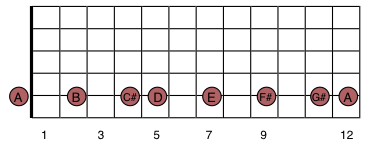Here’s part two of Brad’s article on playing melodies and improvising by ear using the notes of a song’s chords. It’s part of our series on learning to play by ear. You should start with part one if you haven’t already read it!
Welcome back! We’re looking at how to improvise and play over the song “Halo” by Beyoncé, using chord tones. Although we’ll use the guitar for our examples, the principle is the same for any instrument – so grab yours and play along!
First let’s remind ourselves how the song goes and what the chord progression I-ii-vi-IV sounds like:
So far we have found the root notes and thirds. As revision, practise playing through the scale and landing on either the root note of the chord or the third. Feel free to improvise your own lines. Use your ear to guide the resolution from one chord to the next and judge when to land on which notes.
Comfortable with Roots and Thirds? Time to add in a new note: the 5th.
Adding the Fifth
The “Fifth note” of each chord is found by counting up 5 notes from the chord’s root. This interval of a 5th is added to complete the chord which the root and third begin.
Simple chords like this made up of three notes are called triads. If you’re keen on intervals, note that these chords are created from stacked intervals of 3rds. For example B minor has the root note of B. The next note is a 3rd on top of it, D. After D we go up another 3rd to reach the 5th: F#.
Here are the root, third and fifth notes for the A, Bm, F#m and D chords of Halo:
| Note 1 (“root”) | Note 2 | Note 3 (“3rd”) | Note 4 | Note 5 (“5th”) |
|---|---|---|---|---|
| A | B | C# | D | E |
| B | C# | D | E | F# |
| F# | G# | A | B | C# |
| D | E | F# | G# | A |
Let’s try using these notes: play through the progression using the fifth of each chord:

Play through the 5th of each chord
And then add that to the Root and Third you learned before to play through the triads:

Play the root 3rd and 5th – the complete triads
Now play through the tune improvising, but playing only the three notes from each chord.
If you’re using a guitar, try using your ear to find the triads across different strings. Look for common tones and only play these notes on each string. Listen to how each string sounds different. Playing notes on the lower strings may create a different mood to playing notes on higher strings.
If you’re on another instrument, listen to how the notes of each chord relate to one another, and try to choose transitions which you think match the chord progression well.
Chord Tones
Now we have completed the triad. The Root, 3rd and 5th note of each chord scale. These three notes of each chord are important “target tones”. They are what I like to call the safe notes: these notes will always sound right because they are part of the chord already being played. As you play freely over the progression, these notes will reliably sound good and provide a solid basis for your improvisation.
Remember we started with the song’s key scale, the A Major Scale:

Return to the scale with your new appreciation of root, third and fifth
Now that you understand and have practised the root, third and fifth of each chord in the progression, return to this scale and remind yourself how the scale relates to each chord. Use the scale to improvise around the ‘target tones’ of each chord.
After playing within the scale shape for a while your ear should be used to the sound. Your ear now should be able to determine what is “in key” and what is not.
Using your ear as your guide, the next thing you should do is expand from the scale. For guitarists, try to play the scale on each string. For other instruments you might try extending the scale to other octaves by ear (or try the further exercises below).
Here is the A major scale played just on the “A” string:

The A Major Scale on the A String
Try to work this out by ear on every other string too. Then, from the scale, try to find the root note of each chord. Then the 3rds, and 5ths, and connect them as triads.
Here’s an example of the kind of solo you can build using the techniques you’ve learned here:
Beyond Beyoncé
When you get comfortable in the key of A, try another key!
Go through this whole process again for a new song. But! Instead of starting from knowing the scale and choosing the notes… try using your ear to find the chord tones. You should now be getting a feel for what the root, third and fifth of chords should sound like. Try finding the notes by ear. If you want to check, you can search for the song’s chords online and work it out from the key and scale.
Want to really improve fast? Repeat this exercise every day in a new key.
These exercises are a great way to understand popular chord progressions, develop your ear for music, and master improvisation and learning your scales all over your instrument in a fun and practical way.
Any questions? Just ask!







